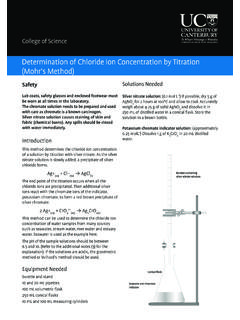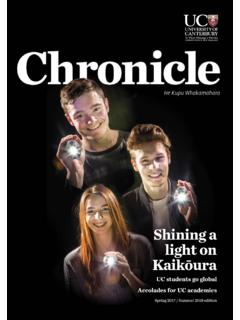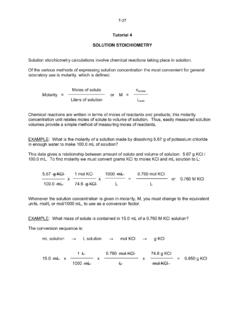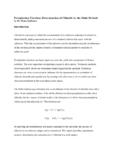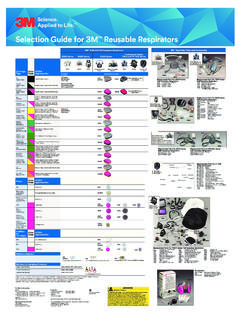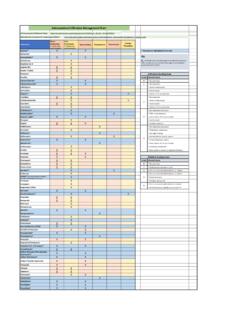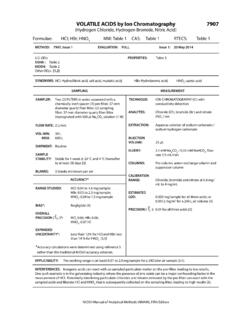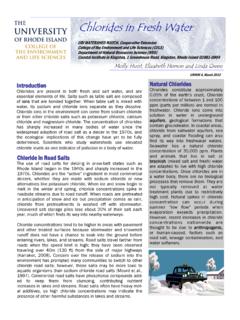Transcription of Determination of Total Calcium and Magnesium Ion …
1 College of ScienceSafety Lab coats, safety glasses and enclosed footwear must be worn at all times in the laboratory. Concentrated ammonia solution used in preparing the buffer and indicator solutions is highly corrosive wear rubber gloves and take care when handling. Both the buffer and indicator (and thus also the titration solution) will liberate ammonia gas to some extent. This gas may be harmful if inhaled in large quantities. Work in a fumehood or well ventilated method, called a complexometric titration, is used to find the Total Calcium and Magnesium content of milk, sea water and various solid materials.
2 It can also be used to determine the Total hardness of fresh water provided the solutions used are diluted. The combined concentration of Calcium and Magnesium ions is considered to be the measure of water method uses a very large molecule called EDTA which forms a complex with Calcium and Magnesium ions. EDTA is short for ethylenediaminetetraacetic acid. A blue dye called Eriochrome Black T (ErioT) is used as the indicator. This blue dye also forms a complex with the Calcium and Magnesium ions, changing colour from blue to pink in the process.
3 The dye metal ion complex is less stable than the EDTA metal ion complex. For the titration, the sample solution containing the Calcium and Magnesium ions is reacted with an excess of EDTA. The indicator is added and remains blue as all the Ca2+ and Mg2+ ions present are complexed with the back titration is carried out using a solution of Magnesium chloride . This forms a complex with the excess EDTA molecules until the end-point, when all the excess EDTA has been complexed. The remaining Magnesium ions of the Magnesium chloride solution then start to complex with ErioT indicator, immediately changing its colour from blue to main reaction isCa2+ + EDTA4 [Ca-EDTA]2 Back titrationEDTA4 + Mg2+ [Mg-EDTA]2 Indicator reaction: note, ErioT is blue and ErioT-Mg is pinkErioT + Mg2+ ErioT-MgEquipment NeededBurette20 mL pipette250 mL conical flasks100 mL volumetric cylinderSolutions NeededEDTA: (ethylenediaminetetraaceticacid) 500 mL of a molL-1 solution.
4 Weigh g of the EDTA salt and dissolve it in 500 mL of distilled water in a volumetric : Dissolve g of ammonium chloride in 57 mL concentrated ammonia (see safety notes). Dilute to 100mL with distilled water in a volumetric flask. The pH should be : molL-1 solution. Weigh g of Magnesium chloride hexahydrate and dilute to 500 mL with distilled water in a volumetric indicator: Dissolve g of Eriochrome Black T indicator in 15 mL of concentrated ammonia solution (or 15 mL of triethanolamine) (see safety notes) and 5mL absolute ethanol.
5 Do not store more than one to two days before use. You may be able to get the ErioT indicator from the University of Canterbury - see the contact details at the of Total Calcium and Magnesium Ion ConcentrationMethodSample PreparationFor samples that are already in solution, such as freshwater, seawater and milk, no further preparation is solid samples such as eggshells and limestone, the samples must first be dissolved in acid. Accurately weigh about g of the solid into a small beaker or conical flask, add about 20 mL dilute hydrochloric acid and allow the solid to completely dissolve (this may take several minutes).
6 Neutralise the unreacted acid with dilute sodium hydroxide solution until the pH of the solution is almost 7 (according to pH indicator paper). For eggshells, the inner membrane will remain undissolved and may be carefully removed from the solution. Transfer the solution to a 100 mL volumetric flask and make up to the mark with distilled of the EDTA Solution1. Pipette a 10 mL sample of the EDTA solution into a conical Add 10 mL of ammonia buffer solution and 1 mL of Eriochrome Black T indicator Titrate the EDTA with the Magnesium chloride solution until the endpoint is reached a permanent colour change from blue to Having determined the average titre of the Magnesium chloride solution, determine the number of moles Given the Mg2+ : EDTA ratio of 1 : 1, calculate the concentration of your EDTA Method for Seawater, Milk and Solid Samples1.
7 Pipette 10 mL of the sample solution into a conical Add 20 mL of mol L 1 EDTA Add 10 mL of ammonia buffer, 50 mL of distilled water and 1 mL of Eriochrome Black T indicator Titrate the sample with the standard molL 1 Magnesium chloride solution until a permanent pink colour Method for Fresh or Tap Water Samples1. Add a 100 mL of the sample solution into a 250 mL conical Prepare a mol L 1 EDTA solution by diluting the mol L 1 EDTA solution by a factor of 1/10. Add 20mL of this diluted EDTA to the sample Add 10 mL of the ammonia buffer and 1 mL of Eriochrome Black T indicator Prepare a mol L 1 Magnesium chloride solution by diluting the mol L 1 Magnesium chloride solution by a factor of 1 Titrate the sample solution with this molL 1 Magnesium chloride solution until a permanent pink colour appears.
8 Repeat the titration with further samples until concordant results (titres agreeing within mL) are 1 Colour changes for Magnesium chloride back-titration in clear solution using Eriochrome Black T indicator. Left flask: blue colour well before endpoint (all Ca2+/Mg2+ ions complexed by excess EDTA, all indicator molecules uncomplexed). Centre flask: last trace of blue/purple colour just before endpoint (excess EDTA almost totally complexed by added Mg2+). Right flask: pink/red colour at endpoint (all EDTA complexed by added Mg2+, indicator also complexed).
9 Figure 2 Same colour changes for Magnesium chloride back-titration as in Figure 1, but for cloudy (opaque) sample solution, eg milk. Left flask: blue colour well before endpoint. Centre flask: last trace of blue/purple. Right flask: pink/red colour at endpoint2 Eriochrome Black T indicator solution. 3. Titrate the EDTA with the Magnesium chloride solution until the endpoint is reached a permanent colour change from blue to pink. 4. Having determined the average titre of the Magnesium chloride solution, determine the number of moles Given the Mg2+ : EDTA ratio of 1 : 1, calculate the concentration of your EDTA Method for Seawater, Milk and Solid Samples 1.
10 Pipette 10 mL of the sample solution into a conical Add 20 mL of mol L 1 EDTA solution. 3. Add 10 mL of ammonia buffer, 50 mL of distilled water and 1 mL of Eriochrome Black T indicator solution. 4. Titrate the sample with the standard molL-1 Magnesium chloride solution until a permanent pink colour appears. Titration Method for Fresh or Tap Water Samples1. Add a 100 mL of the sample solution into a 250 mL conical Prepare a mol L 1 EDTA solution by diluting the mol L 1 EDTA solution by a factor of 1/10.

